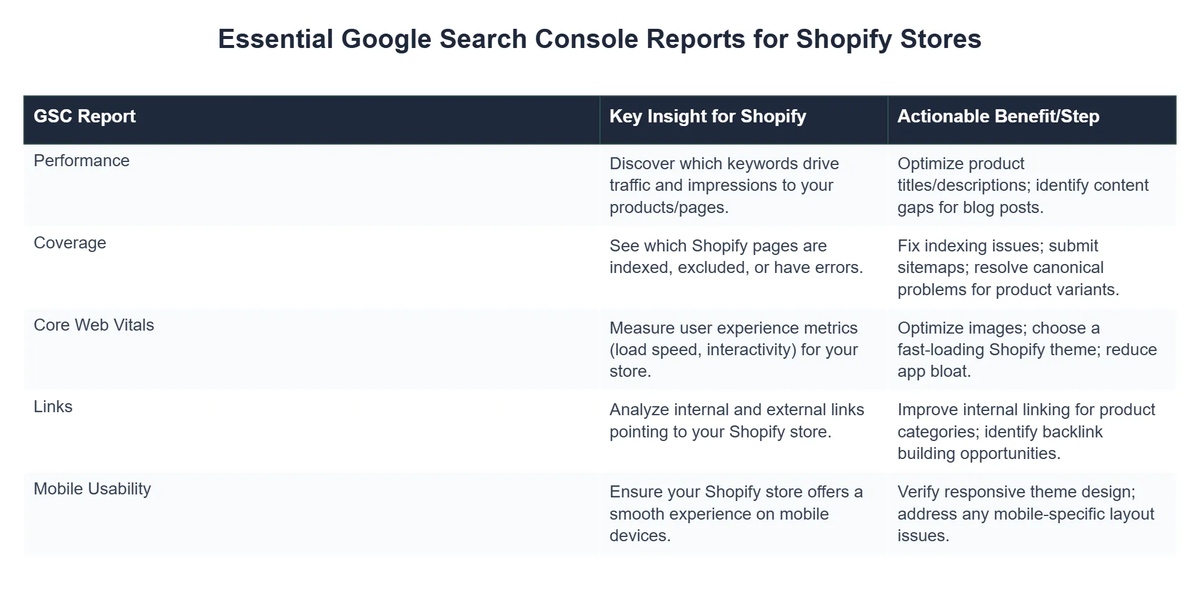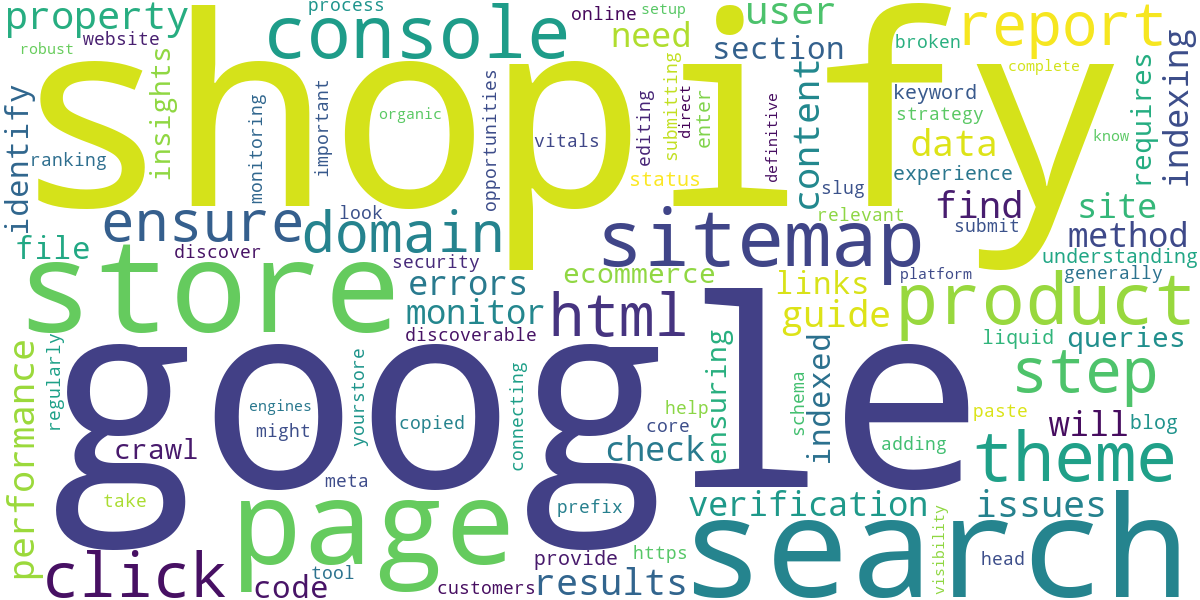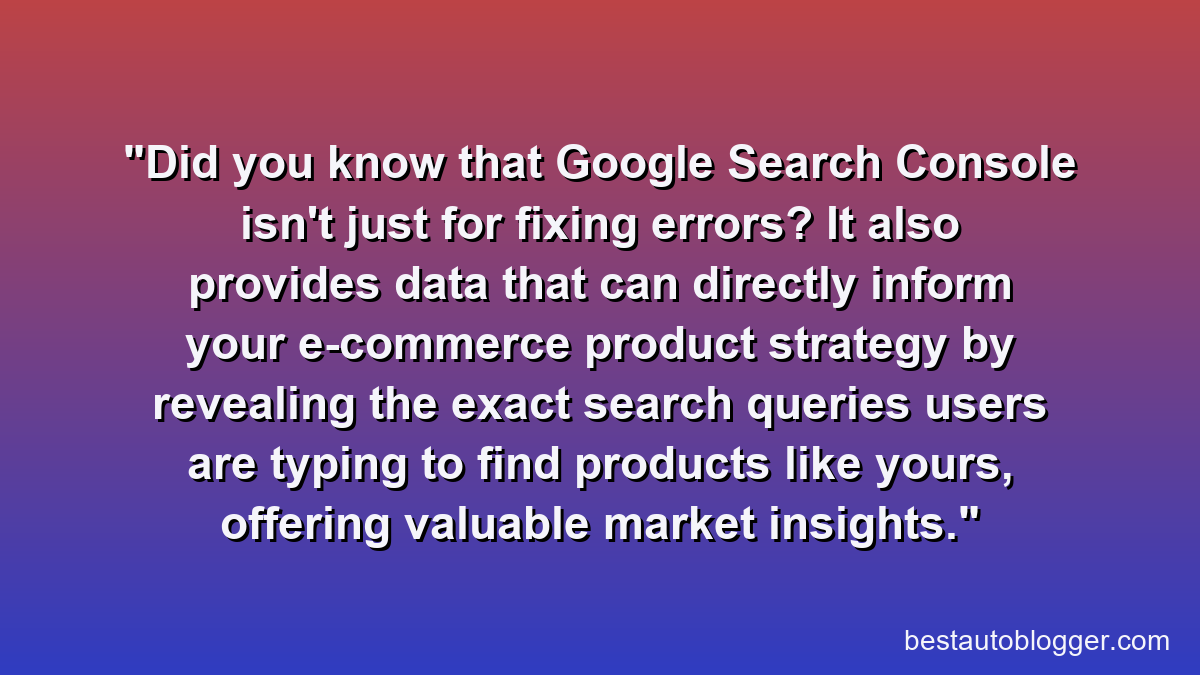Shopify & Google Search Console: A Complete Guide to Setup
For any ambitious online store, visibility in search engines is not just an advantage—it’s a necessity. While your Shopify store provides a robust platform for sales, truly dominating the search results requires a direct line to Google itself. That’s where Google Search Console (GSC) comes in.
Shopify
Shopify is the industry-leading, all-in-one e-commerce platform that empowers entrepreneurs and businesses of all sizes to launch, manage, and scale their online stores with remarkable ease. From intuitive product management and secure payment processing to robust marketing tools and global shipping options, Shopify provides everything you need to sell online efficiently and profitably, freeing you to focus on your vision.
💡 Key Takeaways
- Connecting Google Search Console to Shopify is crucial for accurate SEO data and performance monitoring.
- Learn the simplest methods to verify your Shopify store within Google Search Console for effective tracking.
- Utilize GSC’s tools like sitemaps, Core Web Vitals, and crawl reports to optimize your Shopify store’s visibility.
- Troubleshoot indexing issues and enhance your e-commerce site’s search presence using GSC insights.
“Integrating Google Search Console with your Shopify store isn’t just an option; it’s a fundamental step for any serious e-commerce business looking to understand and improve its search visibility and organic performance.”
— Victoria Nelson, Ecommerce SEO Specialist
This definitive guide will walk you through everything you need to know to add search console to Shopify, ensuring your store is not only discoverable but also optimized for maximum organic traffic. We’ll cover why GSC is indispensable, the precise steps for setup and verification, and how to leverage its insights to boost your ecommerce SEO.
In This Article
- → Shopify & Google Search Console: A Complete Guide to Setup
- — 💡 Key Takeaways
- → Why Google Search Console is Indispensable for Your Shopify Store
- — 📊 Unlocking Performance Insights
- — 🛠️ Identifying and Fixing Errors
- — 🔍 Understanding Your Audience’s Search Behavior
- — 🗺️ Submitting and Monitoring Sitemaps
- → The Essential Steps to Connect Shopify with Google Search Console
- — ➡️ Step 1: Accessing Google Search Console
- — ➕ Step 2: Adding Your Shopify Property
- — 🔒 Step 3: Verifying Your Shopify Store
- → Verifying Your Shopify Store: A Step-by-Step Walkthrough (HTML Tag Method)
- — 📋 Copying the HTML Tag
- — 💻 Pasting into Shopify’s Theme Code
- — ✅ Final Verification in GSC
- → Submitting Your Shopify Sitemap to Google Search Console
- — 📄 Understanding Your Shopify Sitemap
- — 🚀 How to Submit Your Sitemap
- → Initial Data & Key Reports to Monitor in GSC for Shopify
- — 📈 Performance Report
- — 📜 Indexing (Pages) Report
- — ⚡ Core Web Vitals
- — ✨ Enhancements (Products, Sitelinks Searchbox)
- — 🚨 Removals & Security Issues
- → Optimizing Your Shopify SEO with GSC Data
- — 🏆 Improving Organic Rankings
- — 🔗 Fixing Crawl Errors & Broken Links
- — 🌐 Enhancing User Experience (Core Web Vitals)
- — Staying Indexed and Visible
- → Conclusion
Why Google Search Console is Indispensable for Your Shopify Store
Think of Google Search Console as Google’s direct communication channel with your website. It’s a free service that provides crucial data and tools to help you monitor your site’s performance in Google Search results, identify and fix issues, and generally ensure your store is well-represented in the SERPs.
📊 Unlocking Performance Insights
- ✅ See which queries bring users to your store.
- ✅ Analyze your average position, clicks, and impressions.
- ✅ Understand how specific pages perform in search.
🛠️ Identifying and Fixing Errors
- ➡️ Discover indexing issues preventing your pages from appearing in search.
- ➡️ Pinpoint crawl errors (e.g., broken links, server errors).
- ➡️ Receive alerts for security issues or manual actions against your site.
🔍 Understanding Your Audience’s Search Behavior
- 💡 Gain insights into the exact keywords customers use to find products like yours.
- 💡 Use this data to refine your product descriptions, blog content, and overall SEO strategy.
🗺️ Submitting and Monitoring Sitemaps
- 🚀 Ensure Google efficiently discovers and indexes all your important product and category pages.
- 🚀 Monitor the indexing status of your submitted sitemaps.
The Essential Steps to Connect Shopify with Google Search Console
Connecting your Shopify store to GSC is a straightforward process, but it requires precision. Follow these steps carefully to ensure a seamless integration.
➡️ Step 1: Accessing Google Search Console
- Go to Google Search Console.
- Sign in with your Google account. If you don’t have one, you’ll need to create it.
➕ Step 2: Adding Your Shopify Property
Once logged in, you’ll see an option to “Add a property.” You have two choices: “Domain” or “URL Prefix.” For Shopify, either can work, but “Domain property” is generally recommended as it covers all subdomains and protocols (http/https, www/non-www).
- Recommended: Domain Property: Enter your domain name (e.g., `yourstore.com`) into the “Domain” section. Click “Continue.”
- Alternative: URL Prefix Property: Enter the exact URL of your Shopify store (e.g., `https://www.yourstore.com/`) into the “URL prefix” section. Click “Continue.”
🔒 Step 3: Verifying Your Shopify Store
Google needs to confirm you own the Shopify store you’re trying to add. There are several verification methods, but for Shopify, the HTML tag method is often the simplest and most common.
- HTML Tag: You’ll get a meta tag to paste into your Shopify theme’s `theme.liquid` file. This is our focus.
- DNS Record: More complex, requires access to your domain’s DNS settings.
- Google Analytics: If you’ve already set up Shopify Google Analytics 4 Integration, you might be able to use this.
- Google Tag Manager: If you’re using GTM, this can be an option.
We’ll proceed with the HTML tag method, as it directly addresses how to verify your Shopify store’s ownership within the platform itself.
Verifying Your Shopify Store: A Step-by-Step Walkthrough (HTML Tag Method)
The HTML tag method involves adding a small snippet of code to your Shopify theme. This tells Google that you have access to the website’s backend and are its legitimate owner.

📋 Copying the HTML Tag
- In Google Search Console, after adding your property, choose the “HTML tag” verification method.
- You will see a meta tag that looks something like: “.
- Click the “Copy” button to copy this entire tag to your clipboard.
💻 Pasting into Shopify’s Theme Code
This step requires editing your Shopify theme’s code. Always be cautious when editing theme files. Consider backing up your theme first by duplicating it.
- Log in to your Shopify admin dashboard.
- Navigate to Online Store > Themes.
- Find your current theme and click on Actions > Edit code.
- In the “Layout” directory on the left, click on
theme.liquid. This file controls the basic structure of all your store’s pages. - Locate the
<head>section in thetheme.liquidfile. You need to paste the copied HTML tag inside the<head>section, typically just before the closing</head>tag. - Paste the HTML tag you copied from GSC.
- Click Save in the top right corner.
For more detailed instructions on editing theme code, you can refer to Shopify’s official documentation or blogs like How To Use Google Search Console for Your Website (2024).
✅ Final Verification in GSC
Once you’ve saved the changes in Shopify, return to Google Search Console.
- Click the “Verify” button on the HTML tag verification screen.
- Google will check for the meta tag on your site. If it finds it, your property will be successfully verified!
It might take a few moments for Google to process the verification. If it fails, double-check that you’ve copied the entire tag correctly and pasted it in the right place within your `theme.liquid` file.
Submitting Your Shopify Sitemap to Google Search Console
A sitemap acts as a map for search engines, listing all the important pages on your Shopify store. Submitting it to GSC helps Google crawl and index your site more efficiently, ensuring all your products and content are discoverable.
📄 Understanding Your Shopify Sitemap
Shopify automatically generates a sitemap for your store. You can usually find it at your domain followed by `/sitemap.xml` (e.g., `https://yourstore.com/sitemap.xml`). This sitemap includes links to all your products, collections, pages, and blog posts.
For more details on locating your sitemap, consult the Shopify Help Center.
🚀 How to Submit Your Sitemap
- In Google Search Console, select your Shopify property.
- In the left-hand navigation menu, click on Sitemaps.
- Under “Add a new sitemap,” enter
sitemap.xml(assuming your sitemap is at yourdomain.com/sitemap.xml). You don’t need to enter the full domain again, just the path relative to your root domain. - Click Submit.
Google will then process your sitemap. It might take some time for the status to update, but this ensures Google knows where to find all your important pages, making it easier for potential customers to find your store when they `add me to search in google`.
Initial Data & Key Reports to Monitor in GSC for Shopify
Once your Shopify store is verified and your sitemap is submitted, Google Search Console will start collecting data. Here are the key reports you should regularly check to monitor your store’s performance and identify areas for improvement.
📈 Performance Report
This is your go-to report for understanding how your store appears in Google Search. It shows:
- ➡️ Which search queries (keywords) your store ranks for.
- ➡️ The number of clicks and impressions your pages receive.
- ➡️ Your average position in search results.
- ➡️ Performance by page, country, device, and search appearance (e.g., rich results).
Use this to identify top-performing content and opportunities for new content or product pages.
📜 Indexing (Pages) Report
Crucial for an ecommerce site, this report tells you which of your pages have been indexed by Google and which haven’t (and why). You want as many of your product and collection pages as possible to be indexed so that Google can `add me to search google` for relevant queries.
- 💡 Monitor “Page indexing” to see if there are errors preventing pages from being indexed.
- 💡 Look for “Excluded” pages and understand the reasons (e.g., “Crawled – currently not indexed,” “Duplicate without user-selected canonical”).
⚡ Core Web Vitals
These metrics measure user experience aspects like loading speed, interactivity, and visual stability. Poor Core Web Vitals can negatively impact your rankings and user satisfaction. Shopify generally provides a fast base, but app bloat or large images can cause issues.
- ➡️ Check both mobile and desktop scores.
- ➡️ Identify URLs that need improvement.
✨ Enhancements (Products, Sitelinks Searchbox)
This section shows if your structured data (Schema Markup) for products is being detected and rendered correctly in search results (e.g., showing star ratings, prices, availability). Shopify often adds basic product schema, but monitoring here ensures it’s valid.
- 💡 Ensure your product pages have valid schema to potentially gain rich results.
🚨 Removals & Security Issues
- ➡️ Use the Removals tool to temporarily hide content from Google Search results (e.g., if you temporarily remove a product page).
- ➡️ The Security issues report alerts you to any malware or hacking attempts on your site.
Optimizing Your Shopify SEO with GSC Data
Setting up GSC is just the first step. The real power lies in using the data to make informed SEO decisions for your Shopify store. This is a critical component of any strong Ecommerce SEO: The Definitive Guide for Online Stores strategy.
🏆 Improving Organic Rankings
- ✅ Identify Keyword Opportunities: Use the Performance report to find keywords you’re ranking for on page 2 or 3. Optimize those pages (improve content, add relevant internal links) to push them higher.
- ✅ Discover New Content Ideas: Look for unexpected queries that bring traffic. These can inspire new blog posts, product variations, or FAQs.
🔗 Fixing Crawl Errors & Broken Links
- ➡️ Regularly check the “Pages” report for errors. Broken links (404s) can waste crawl budget and frustrate users. Redirect old URLs to new, relevant pages on Shopify.
- ➡️ Ensure your internal linking structure is robust. For more on ensuring your store is discoverable, consider our guide on Shopify & Google Search Console: A Complete Guide to Connecting Your Store.
🌐 Enhancing User Experience (Core Web Vitals)
- 💡 Work on improving page loading times by optimizing images, reducing unnecessary app scripts, and ensuring your Shopify theme is lightweight.
- 💡 A better user experience translates to lower bounce rates and potentially higher conversions.
Staying Indexed and Visible
- 🚀 Regularly submit updated sitemaps if you make significant changes to your store (e.g., add many new products).
- 🚀 Monitor the indexing status to ensure Google can always `add me to search in google` and include your latest offerings.
- 🚀 Use the URL Inspection tool to quickly check the status of individual pages and request indexing if needed.

Recommended Video
Connecting your Shopify store to Google Search Console is not merely a technical checkbox; it’s a fundamental step towards understanding your store’s visibility in search, diagnosing issues, and unlocking significant growth opportunities. By consistently monitoring GSC reports and acting on the insights they provide, you can refine your SEO strategy, improve user experience, and ensure your products reach the customers who are actively searching for them. Don’t leave your search performance to chance – set up GSC today and take control of your Shopify store’s future in Google Search.
Why should I connect Google Search Console to my Shopify store?
Connecting GSC allows you to monitor your site’s search performance, identify indexing issues, submit sitemaps, and understand how Google crawls and ranks your e-commerce store, all vital for SEO.
What’s the easiest way to verify my Shopify store in GSC?
The HTML tag method is often the simplest for Shopify users, as it involves pasting a unique meta tag directly into your store’s theme code without needing file uploads or DNS changes.
Can GSC help me improve my Shopify store’s SEO?
Absolutely. GSC provides critical data on search queries, clicks, impressions, crawl errors, and mobile usability, which are all essential for optimizing your Shopify store’s SEO strategy and driving organic traffic.
Shopify
Ready to take the next step? See how Shopify can help you achieve your goals.







